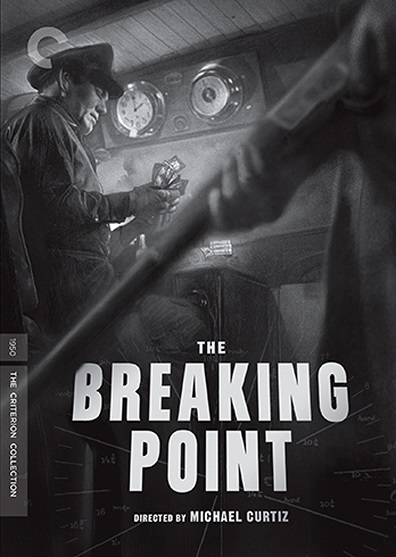
The Breaking Point
Studio: Criterion
Aug 08, 2017
Web Exclusive
![]()
Ernest Hemingway’s 1937 novel To Have and Have Not has been adapted into five films over four decades. The most famous adaption is the first, and the only one to retain the title of the original work. Released in 1944, To Have and Have Not heavily reframed Hemingway’s novel to capitalize on star Humphrey Bogart’s smash hit Casablanca, which had won Warner Brothers a Best Picture Oscar the previous year. Today the film is best remembered as being the first of four pairings between Bogart and his future wife Lauren Bacall, making her film debut as the slinky pickpocket, Slim. Although the mythology of their real-life relationship has propelled the 1944 version to fame, the film plays like what it is: a breezy, low-stakes retread of Casablanca buoyed by Hawks’ trademark snappy dialogue and the chemistry between its leads. Ironically, when Warner Brothers decided to remake the film in 1950 – modern remake culture has nothing on Golden Age Hollywood – they brought aboard one of the most successful journeyman directors in the history of cinema: Michael Curtiz, winner of the Best Director Oscar for Casablanca.
Hawks’ version of the film shifts the action from the Florida Keys to Martinique and makes the story a wartime romance, with protagonist Harry Morgan smuggling French resistance fighters under the nose of the treacherous Vichy regime. Although the Curtiz version – retitled The Breaking Point – once again transposes the action to Southern California and Mexico, it hews much closer to Hemingway’s original plot and themes. Instead of a roguish mercenary, Morgan – here played by John Garfield – is a former soldier turned sport-fishing boat captain, renting out his vessel to wealthy tourists to provide for his wife and two daughters. Both Morgans are forced to take illegal jobs to make ends meet, but whereas Bogart’s wartime version of Morgan gets to commit crimes in the name of freedom, Garfield’s Morgan finds his illicit compromises to be far more sinister and complex.
Despite being made only six years after its predecessor, The Breaking Point makes an excellent case study in how much Hollywood filmmaking was beginning to change in the wake of World War II. With the Nazis defeated, years of morally convenient plots and adversaries were out the window and Hollywood was forced to present conflicts in increasingly grey shades. The then thriving form of film noir, newly emerging naturalistic acting techniques and the slow decline of the studio system all combined to make films like The Breaking Point: old stories packaged in new ways. Although he’d made over 100 films in the studio system by 1950, Curtiz’s direction is anything but stagey, his themes anything but black and white. Whereas the films of the war years sought to rouse audiences with exotic locales and foreign intrigues, Curtiz keeps The Breaking Point focused squarely on working class struggle and the poison of masculine pride. This incarnation of Harry Morgan no longer possesses the glib disreputableness of the standard Bogart hero. Garfield effortlessly embodies the masculine ruggedness that defines any Hemingway protagonist but he maintains an undercurrent of shifty desperation in his performance; his Harry is a man trapped by bad luck, circumstance and his own inability to know when to call it quits. As he takes increasingly dangerous jobs – first smuggling illegal Chinese immigrants, later acting as a getaway boat for a racetrack robbery – he can no longer pretend that he’s doing it for his children or his long-suffering wife. He’s doing it because he can’t stand to fail at the American Dream, a theme that would pervade much of Hollywood’s post-war output.
Curtiz and screenwriter Ranald MacDougall do an excellent job of ensuring that everyone around Harry – family, friends, and enemies – suffers in some way because of their association with him. The odd exception is Patricia Neal as Leona Charles, the films’ toothy blonde of a femme fatale. Although she’s playing the rough equivalent of Bacall’s jet-setting pickpocket from the 1944 version, Neal and the filmmakers put a different spin on the trope of the villainous temptress. Yes, Leona flirts with Harry and they kiss at one point, but roughly halfway through the film – following an excellent scene in which Leona meets Harry’s wife and they realize how much they like each other – she becomes less a temptation for Harry and more of a moral sounding board. The film never judges her and doesn’t punish her for her moral status. The writing and Neal’s performance – all knowing grins and lazy posturing – transforms her into a sort of mascot for The Breaking Point as an arrow pointing toward a new, grayer American cinema. As Leona says herself, “Nice? There’s no future in nice.”
www.criterion.com/films/28695-the-breaking-point
Current Issue

Issue #72
Apr 19, 2024 Issue #72 - The ‘90s Issue with The Cardigans and Thurston Moore
Most Recent
- Mitski Shares a New Video for “Star” (News) — Mitski
- Waiting in the Sky (Before the Starman Came to Earth) (Review) — David Bowie
- Challengers (Review) —
- Premiere: Eric Schroeder Shares New Track “The Kind of Wound That Never Heals” (News) — Eric Schroeder
- Thurston Moore Shares New Song “Rewilding” (News) — Thurston Moore, Sonic Youth

Comments
Submit your comment
There are no comments for this entry yet.